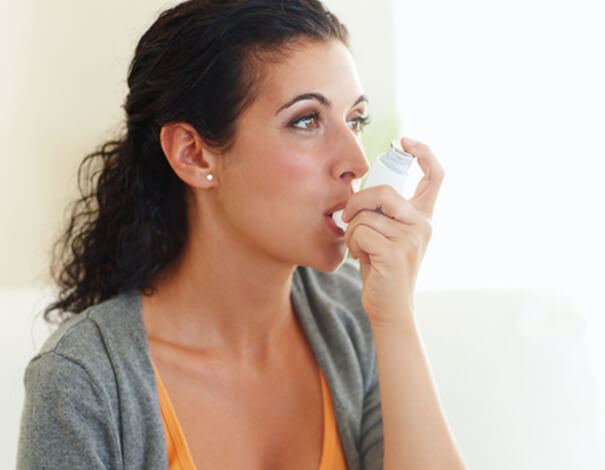Chronic Obstructive Pulmonary Disease (COPD) Causes, Symptoms & Treatment
Chronic obstructive pulmonary disease (COPD) is a progressive lung disease that affects more than 2 million Canadians. Read on to learn more about this disease and how it can be treated to improve quality of life.
What is COPD?
When you inhale, your lungs expand to take in fresh, oxygen-rich air. The air travels to the alveoli, which are thousands of tiny sacs at the end of the bronchi. In the alveoli, oxygen passes through the alveoli walls into the bloodstream, and carbon dioxide passes from the bloodstream into the alveoli. When you exhale, the lungs contract, pushing the carbon dioxide out.
In COPD, airflow through the lungs and gas exchange in the alveoli are impaired because of chronic bronchitis or emphysema.
Chronic bronchitis
In chronic bronchitis, the walls of the bronchi are inflamed, reducing the space available for airflow. The lungs also produce more mucus, which further restricts airflow. This leads to a persistent cough as you try to get rid of the mucus.
Emphysema
In emphysema, the walls of the alveoli are damaged, reducing the lungs’ ability to exchange oxygen and carbon dioxide and to expand and contract to force air out. This causes shortness of breath, also known as dyspnea.

What causes COPD?
Tobacco use is responsible for 80% to 90% of COPD cases. While most cases of COPD are caused by tobacco use, not all smokers will develop this lung disease. Exposure to second-hand smoke, occupational exposure to dusts or fumes (e.g., grain or wood dust, smoke, fuel), and repeated respiratory infections during childhood are other important risk factors. Research has also shown that a genetic defect is associated with an increased risk of COPD.
COPD usually occurs in people over the age of 40. In people who continue to smoke, the disease will continue to progress. Quitting smoking is the only way to slow the progression of the disease, as current treatments can only relieve symptoms.
COPD can also increase the risk of heart failure, because the heart must work harder to pump blood through damaged lungs.
How is COPD diagnosed?
The diagnosis of COPD is based on a physical exam, a health questionnaire, and a breathing test called spirometry. Spirometry is important to confirm the diagnosis because some symptoms of COPD are similar to those of other lung diseases, such as asthma. In someone with COPD, the breathing test will not improve after a bronchodilator is administered, which it does when the person has asthma.
What are the symptoms of COPD?
The first symptoms often go unnoticed. People tend to dismiss coughing and shortness of breath as normal for smokers or their age. They usually consult a doctor when symptoms have become severe enough that they interfere with daily activities.
People with COPD can experience the following symptoms:
- difficulty breathing or the feeling of being short of breath (dyspnea)
- persistent cough
- excessive production of bronchial secretions
- chest pressure
- constant fatigue
- weight loss (in the case of emphysema)
At the onset of the illness, patients typically experience breathlessness only when they engage in strenuous activity. However, as the disease progresses, symptoms manifest even during less intense activities, eventually becoming present at rest.
How is COPD treated?
COPD can't be cured, but treatment can control symptoms, reduce the risk of lung infections, reduce mortality, and preserve quality of life.
Smoking cessation
If you still smoke, quitting is the only intervention that can stop the disease from progressing. It will also reduce the risk of complications, such as cardiovascular disease and lung cancer.
Quitting is not easy, but your pharmacist can prescribe smoking cessation aids and support you until you succeed. You should also try to avoid second-hand smoke, air pollution, and irritants (e.g., perfumes, dust), which are also harmful to the lungs.
Healthy lifestyle
Getting regular physical activity is important. Exercise improves lung capacity, resistance to infections, and cardiovascular health. It also has a positive effect on sleep and mood. When combined with a healthy diet, exercise also helps you maintain a healthy weight and gives you more energy.
A healthy diet is especially important for people with emphysema. Because of their damaged lungs, they need more energy to breathe. A registered dietician can help you make the right food choices.
If you have chronic bronchitis, you should drink plenty of liquids daily (unless your doctor tells you otherwise). Staying hydrated makes airway secretions less sticky and easier to expel.
Pulmonary rehabilitation
A good way to improve your quality of life is to join a pulmonary rehabilitation program. These programs are designed to help people with COPD live better. You'll learn breathing strategies, exercise tips, stress management and other techniques to improve your quality of life. Your pharmacist or your doctor can help you find a program in your area. Some programs are offered online.
Vaccination
Several vaccines are recommended for people with COPD to reduce the risk of complications from viral infections, including influenza, COVID-19, and pneumococcal vaccines.
Respiratory syncytial virus (RSV) is another virus that can cause serious complications in people with COPD. A vaccine against RSV is available in Canada for people 60 years and older, but it is not currently covered by public health insurance. Some private insurers may cover it. Talk to your pharmacist to find out if this vaccine is right for you.
Remember that good hand hygiene is a simple way to reduce your risk of contracting or spreading germs.
Prescription medication
There are several types of medications currently available to treat COPD, and most of these medications are inhaled. Your pharmacist will show you how to use your inhalers correctly to get the maximum benefit from the medication. You should ask your pharmacist to check your technique at least once a year to make sure you are still using your inhaler correctly. It’s easy to forget steps over time, which can lead to less effective treatment.
Bronchodilators open the airways to let air pass more easily, which relieves shortness of breath. There are 2 classes of bronchodilators: beta2-agonists and anticholinergics. Your doctor may prescribe both, since they act differently to relieve shortness of breath and decrease coughing. Long-acting bronchodilators are used regularly every day and short-acting bronchodilators are used as rescue medication if you become short of breath despite your maintenance treatment.
Inhaled corticosteroids can be used with bronchodilators to help reduce the risk of acute exacerbations (flare-ups) in people who have repeated episodes despite their bronchodilator therapy.
Supplemental oxygen
Some people will need to be put on supplemental oxygen. This can be for a short period, for example, during flare-ups, or over the long term for more advanced cases of COPD. A lack of oxygen makes the heart work harder, increases shortness of breath, decreases quality of life and increases confusion. Oxygen therapy makes up for the lack of oxygen in the blood and improves the quality of life.
What is an acute exacerbation (flare-up)?
It is not uncommon for COPD symptoms to worsen because of an acute respiratory infection (e.g., a cold or the flu) or because of exposure to irritants (e.g., smog, smoke). This is called an acute exacerbation.
Signs and symptoms of an acute exacerbation may include increased fatigue, shortness of breath or coughing (compared to usual), a change in colour of mucus (yellow, green, or brown), increased amount, thickness or stickiness of mucus, fever, sore throat or cold symptoms, swollen ankles, having to sleep sitting up instead of lying down or feeling unusually sick or unwell.
During an acute exacerbation, maintenance medication should be taken as usual and rescue medication can be used more frequently to relieve shortness of breath.
Antibiotics may be needed if the mucus is coloured (yellow, green, or brown) and more abundant than usual, or if it is associated with increased shortness of breath, as this is usually associated with a bacterial infection.
If the exacerbation is caused by a viral infection, such as the flu or COVID-19, antiviral medications may be prescribed. Prednisone may also be prescribed during an acute exacerbation to improve breathing.
Your healthcare professional may give you an action plan that includes prescriptions for antibiotics and prednisone with instructions on when to use them. This will allow you to start treatment yourself if you have another flare in the future. If you are not sure when to take the antibiotic or prednisone for your symptoms, ask your pharmacist for professional advice.
If you don’t have an action plan, and you have symptoms of a lung infection, consult your healthcare team. If you have any of the following warning signs in addition to your other symptoms, you should call 911 or ask someone to take you to the emergency room:
- chest pain;
- dizziness, confusion;
- blue lips or fingers.
Why support is important!
Like most chronic diseases, COPD can affect sleep or cause anxiety or a depressed mood. Should you experience any of these symptoms, don’t hesitate to consult with a healthcare professional, such as your doctor, pharmacist, or psychologist. With the assistance of a support group or your family and friends, as well as the guidance of a healthcare professional, you can successfully overcome these challenges.
Your pharmacist can help!
If you have any questions about COPD or your medicines, don't hesitate to ask your pharmacist for professional advice. In some provinces, pharmacists can make changes to COPD treatment to improve its effectiveness or safety.
The pharmacy services presented in this section are offered by pharmacist owners who are affiliated with Uniprix. The pharmacists are solely responsible for the professional activities carried out during the practice of pharmacy. These services are offered in participating pharmacies only. Certain fees and conditions may apply.
* The information contained herein is provided for informational purposes only and is not intended to provide complete information on the subject matter or to replace the advice of a health professional. This information does not constitute medical consultation, diagnosis or opinion and should not be interpreted as such. Please consult your health care provider if you have any questions about your health, medications or treatment.




